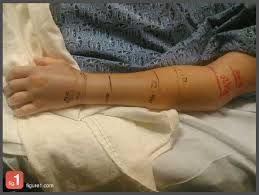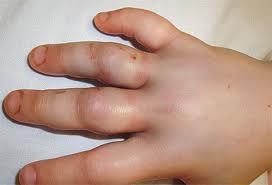- Clinical Technology
- Adult Immunization
- Hepatology
- Pediatric Immunization
- Screening
- Psychiatry
- Allergy
- Women's Health
- Cardiology
- Pediatrics
- Dermatology
- Endocrinology
- Pain Management
- Gastroenterology
- Infectious Disease
- Obesity Medicine
- Rheumatology
- Nephrology
- Neurology
- Pulmonology
Taking the Venom Out of Snake Bites
Reactions range from mild and localized to life-threatening and even fatal. All bites must be treated as true emergencies.
Figure A - Rattlesnake bite resulted in compartment swelling in the forearm.

Figure B - A girl’s snakebitten hand shows swelling and puncture wounds.

Figure C - The ring finger of a boy bitten by a copperhead was ecchymotic and dusky.

An estimated 7000 to 8000 persons receive venomous snake bites in the United States each year. Roughly 95% of the bites are from crotalids. Most snake bites are accidental and occur while the victim is doing home improvements, gardening, or recreating. About 98% occur on the extremities, especially on the hands and arms. Reactions range from mild and localized to life-threatening and even fatal.
Hand edema was present in a patient bitten by a rattlesnake upon arrival at the hospital (Figure A); proximal progression of edema was measured at regular intervals. Rattlesnakes are a member of the Crotalinae subfamily; crotalid venom has multiple effects on human tissues. The measurements in this image from Figure 1 are being used to follow compartment swelling in the forearm.
A 4-year-old girl was bitten by “something” when there were reports of copperhead sightings in the area. Her right arm was markedly swollen with multiple ecchymoses up to the proximal elbow. She had 2 puncture wounds on her right hand at the base of the metacarpal joints of the third and fourth digits (Figure B). Within 24 hours after treatment, her symptoms had decreased markedly. Misconceptions about the initial care of snake bites persist, so a brief review for patients and parents might help.
An 8-year-old boy bitten by a copperhead sustained a tiny puncture wound to the palmar aspect of his distal left ring finger and a scratch to the distal long finger. The 2 affected fingers had swelled immediately, and moderate edema extended to the palmar crease. The ring finger was ecchymotic and dusky, as shown in Figure C. Multiple fasciotomies were performed. After treatment, he regained normal function of every finger.
All snake bites must be treated as true emergencies. If clinical examination results are positive, the first step is immediate antivenin therapy.
